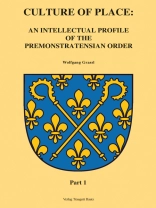Intellectual and cultural histoty has given the Order of the Canons Regular of Prémontré less attention than the its significant achievements would merit. There are studies on individual monasteries, persons, or works, but no comprehensive profile of the Order as a religious movement of Augustinian spirituality has been produced. Based on more than 230 primary works of various genres by Premonstratensian canons of all eras and regions and on more than 900 secondary sources, this book reconstructs a Premonstratensian intellectual style which found its expression in works of theology, philosophy, science, and art. Consideration is given not only to the most widely known personalities such as Anselm of Havelberg, Adam Scotus and Philip of Harvengt, but also to numerous notable persons of lesser renown, for example François Placet, Hieronymus Hirnhaim, Épiphane Louys, Macarius Havermans, Johann Zahn, Manuel Abad Illana, Jaume Caresmar, and László Mécs. Case studies of 35 authors of the Order reveal that underlying the diversity of expressions there are common traits (in the sense of ideal types) that result from a strongly Augustinian theology and a shared canonical form of life. Recognition of such commonalities has long been thwarted by the traditional autonomy of individual canonries. This ‘culture of place’ is itself one of the characteristics of the Premonstratensian intellectual style.
Der Orden der Prämonstratenser-Chorherren hat in der Kultur- und Geistesgeschichte weniger Beachtung gefunden als seine Leistungen verdienten. Zwar gibt es Studien zu einzelnen Klöstern, Persönlichkeiten, oder Werken, aber keine umfassende Betrachtung der ‘Gestalt’ des Ordens als religiöse Bewegung augustinischer Spiritualität. Auf der Grundlage von etwa 230 Primärwerken von Prämonstratensern seit dem 12. Jahrhundert sowie von mehr als 900 Sekundärquellen wird hier ein intellektueller Stil des Ordens rekonstruiert, der sich in Werken der Theologie, Philosophie, Wissenschaft und Kunst niederschlug. Nicht nur die Großen der Prämonstratenser wie Anselm von Havelberg, Adam Scotus und Philipp von Harvengt finden Beachtung, sondern auch zahlreiche weniger bekannte und doch interessante Persönlichkeiten wie etwa François Placet, Hieronymus Hirnhaim, Épiphane Louys, Macarius Havermans, Johann Zahn, Manuel Abad Illana, Jaume Caresmar, oder László Mécs. Einzelbetrachtungen von 35 Autoren des Ordens führen trotz aller Diversität zu einer idealtypischen Beschreibung von Gemeinsamkeiten, die sich aus einer stark augustinisch geprägten Theologie und einer gemeinsamen kanonikalen Lebensweise erklären lassen. Die Erkenntnis solcher Gemeinsamkeiten wurde lang durch die traditionelle Autonomie einzelner Kanonien erschwert, wobei eben die ‘Kultur der Örtlichkeit’ selbst eine der Charakteristika des prämonstratensischen Denkstils darstellt.
The Author
Wolfgang Grassl is a professor at St. Norbert College in De Pere, Wisconsin. His fields of research are business and economics, Catholic social thought, and intellectual history.
Der Autor
Wolfgang Grassl lehrt als Professor am St. Norbert College in De Pere, Wisconsin. Seine Forschungsgebiete sind Wirtschaftswissenschaften, katholische Soziallehre, und Ideengeschichte.
Table of Content
PREFACE
NOTE ON TEXTUAL CONVENTIONS
1. IDENTITY
2. INTELLECTUAL STYLES
3. PREMONSTRATENSIAN INTELLECTUAL LIFE
3.1. Middle Ages
3.2. Reformation and Humanism
3.3. Baroque and Reaffirmation
3.4. Enlightenment and Revolution
3.5. Restoration and Adaptation
3.6. The Twentieth Century and Since
3.7. Shifting Centres
4. PREMONSTRATENSIAN NOTABLES
4.1. Anselm of Havelberg (c.1095-1158)
4.2. Philip of Harvengt (c.1100-1183)
4.3. Adam Scotus (c.1140-1212/13)
4.4. Vivianus of Prémontré (d.c.1160)
4.5. Joannes de Sacrobosco (c.1195-1256)
4.6. Thomas of Breslau (1297- c.1378)
4.7. Stephan Bodeker (1384-1459)
4.8. Kaspar Mohr (1575-1625)
4.9. Chrysostomus (Joannes) van der Sterre (1591-1652)
4.10. Augustinus Franciscus Wichmans (1596-1661)
4.11. Épiphane Louys (1614-1682)
4.12. Luis Tineo de Morales (c.1620-1693)
4.13. François Placet (c.1635-1690)
4.14. Hieronymus Hirnhaim (1637-1679)
4.15. Johann Zahn (1641-1707)
4.16. Macarius Havermans (1644-1680)
4.17. Leonard Goffiné (1648-1719)
4.18. René Aubert de Vertot (1655-1735)
4.19. Charles-Louis Hugo (1667-1739)
4.20. Prokop Diviš (1698-1765)
4.21. Sebastian Sailer (1714-1777)
4.22. Manuel Abad Illana (1717-1780)
4.23. Georg Lienhardt (1717-1783)
4.24. Jaume Caresmar (1717-1791)
4.25. Jean-Baptiste L’Écuy (1740-1834)
4.26. Chrysostomus (Lorenz) Pfrogner (1751-1812)
4.27. Martin Alois David (1757-1836)
4.28. Ladislav Josef Jandera (1776-1857)
4.29. Josef Franz (Stanislaus) Zauper (1784-1850)
4.30. Josef František Smetana (1801-1861)
4.31. Adolf Kunc (1841-1905)
4.32. Xavier de Fourvière (1853-1912)
4.33. Iréneusz (József) Károly (1854-1929) 4.34. László Mécs (1895-1978)
4.35. Norbert Calmels (1908-1985)
5.The Premonstratensian Intellectual Style
5.1. Traditionalism over Progressivism
5.2. Realism over Idealism
5.3. Fideism over Rationalism
5.4. Interiority over Externalism
5.5. Affective over Speculative Theology
5.6. Praxis over Theoria
5.7. Particularism over Universalism
5.8. Moral Rigorism over Laxism
5.9. Catholic Orthodoxy over Heresy
5.10. History as Providence over History as Man-Made
5.11. Communitarianism over Individualism
5.12. Devout Humanism over Scholastic Intellectualism
6.The Augustinian Matrix
7. A Culture of Place
8. The Premonstratensian Contribution
BIBLIOGRAPHY
Premonstratensian Sources
Primary
Secondary
Other Sources
Index of Persons
Premonstratensians
Other Persons







![Cover of Brian Schrag & Julisa Rowe: Community Arts for God's Purposes [Chinese] 貼近神心意的社群藝術 Cover of Brian Schrag & Julisa Rowe: Community Arts for God's Purposes [Chinese] 貼近神心意的社群藝術](https://static.worldofdigitals.com/thumb_webp/740/9781645083740.webp)




